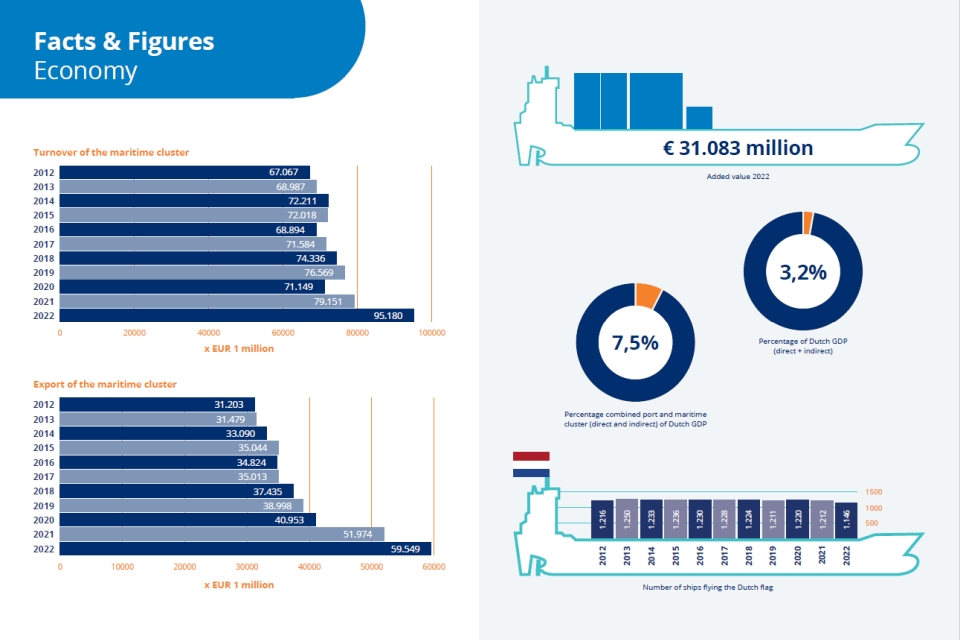On behalf of the Ministry of Infrastructure and Water Management and in collaboration with the Dutch Maritime Network (Nederland Maritiem Land, NML), Ecorys and the Erasmus Centre for Urban, Port and Transport Economics (Erasmus UPT) carried out the annual monitoring study for the maritime cluster. The Maritime Monitor shows that the maritime industry’s contribution to the Dutch GDP is on the rise.
The turnover of the maritime cluster amounted to EUR 95.2 billion in 2022. The cluster generated a direct added value of approximately EUR 25.9 billion in the Netherlands. An additional EUR 5.2 billion was added indirectly. The maritime cluster thus generates approximately 3.2 per cent (2021: 3.0 per cent) of the gross domestic product (GDP) of the Netherlands.
In 2022, the maritime cluster employed 305,765 employees, of which approximately 201,914 were direct labour. The maritime cluster therefore provides 3.0 per cent (2021: 3.0 per cent) of employment in the Netherlands.
Also read: ‘Maritime sector is good for our economy and jobs’
Direct added value increases
The direct added value of the maritime cluster has increased by 21 per cent compared to the 2021 figures. The direct added value has therefore increased faster than direct employment (+2.5 per cent compared to 2021). This means there is a strong Covid recovery. Total employment (including indirect effects) has even increased by 6.0 per cent in 2022.
However, there are major differences per sector within the maritime cluster when looking at developments in direct added value over the period 2006-2022 (with 2006 set at 100). The strongest increase took place in the port/logistics, maritime services and inland navigation sectors. These sectors went up from the 2006 100 baseline to 173, 187 and 216 respectively in 2022.
Yet, when looking at yacht building, this sector remained relatively stable in direct added value over this period, whereas the sectors fishing and shipbuilding saw a major decline. Fishing dropped from the 2006 baseline (100) to just below 75 and shipbuilding to just over 50.
The total exports of the maritime cluster amounted to more than EUR 59.5 billion in 2022. In 2021 this was only EUR 52.0 billion. The export performance of the maritime cluster has therefore grown strongly. Of a total export from the Netherlands of EUR 731 billion, the maritime cluster’s share is 8.1 per cent.

Combined port and maritime cluster 2022
The direct added value of the combined port and maritime cluster amounted to EUR 50.4 billion in 2022. A significant increase compared to 2021 and 2020 (2021: EUR 39.0 billion and 2020: EUR 32.8 billion). The combined direct employment in the port and maritime cluster equalled 303,960 in 2022 (measured in employees).
As soon as the indirect added value is included, an additional EUR 22.0 billion of added value is realised, bringing the total added value of the combined cluster to EUR 72.4 billion in 2022. The cluster’s total employment impacts add up to 575,490 workers in 2022.
When we compare this data to the Dutch GDP, the direct added value contribution of the combined cluster to Dutch GDP is 5.3 per cent and when the indirect effects are also included, the contribution of the combined cluster is 7.5 per cent to the Dutch GDP for 2022. In recent years, the contribution to added value has increased significantly from 6.2 per cent in 2020 and 6.8 per cent in 2021.
In 2022, 3.0 per cent of direct employment in the Netherlands is due to the combined port and maritime cluster. When the indirect effects are also included, the combined port and maritime cluster provides 5.7 per cent of employment in the Netherlands.
Pictures by the Dutch Maritime Network (NML).
Also read: SWZ|Maritime’s January 2023 issue: Maritime sector has much to offer








